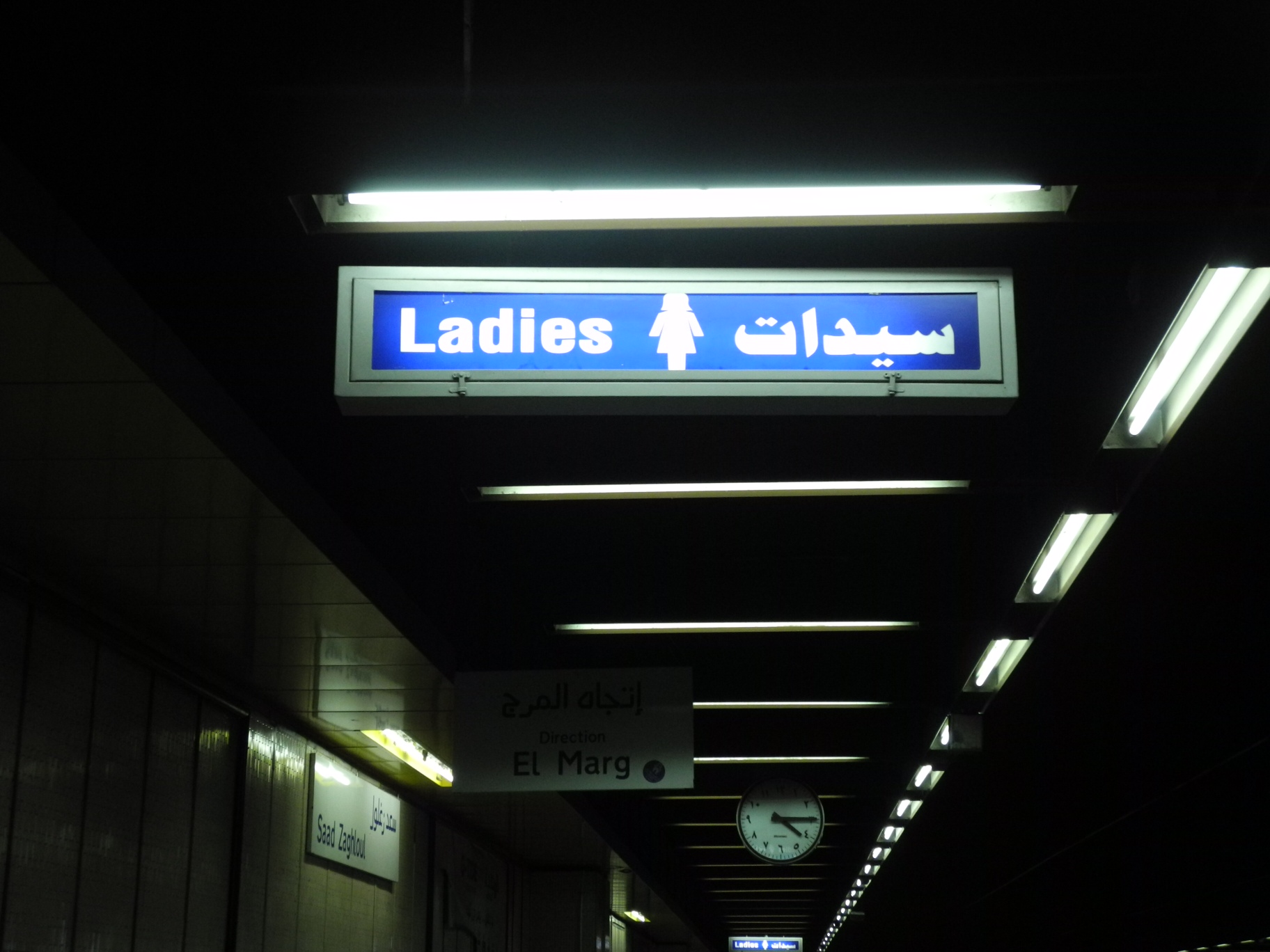The unmistakable red and green stickers on the women’s subway cars showing the quintessential stick-figure of a woman with a triangle for a dress give the sensation that one is going into the women’s toilet instead of work.
The segregation of the sexes in Cairo’s subway cars was implemented since the subway´s conception in 1987, and to this day, remains a mirror of society’s conception, placement and treatment of women and their fight for respect.
A young woman stepped into a half empty women’s car of Cairo’s subway on the first day of Ramadan. This time around, a woman was the uninviting element disrupting the car’s drowsy air; a striking change from the usual man surreptitiously entering through the subway’s doors as they opened lazily.
The young women walked into her designated space for “safe” public transport only to realize men were already part of it.
When she chose to reclaim it, and before reaching the next stop, she was on the ground, knocked down by a man’s heavy slap across her face. When the subway reached Shuhada, the subway’s central unit, the girl stood alone with the echo of a handful of “ma3lesh”, Arabic for I am sorry, and the ghost of another harasser.
Ninety-nine percent of women in Egypt have experienced a form of sexual harassment, according to a report by the UN Women published in 2013, with public transportation being the second highest ranking place for sexual harassment takes place, just below the streets.
The prevalence and spike of gender violence, with the most recent case of gang rape in Tahrir Square during a rally celebrating Sisi’s inauguration last June, makes sex segregation inside the subway an urgent measure to fight the endemic problem.
“Men ride the women’s car and specifically ride it just to target women,” said Rebecca Chiao, founder of Harassmap a volunteer-based initiative that works to end the social acceptability of sexual harassment.
Despite the segregation’s short term goal of providing a safe space for women, rightly considered as such by many Egyptian women, segregation’s end goal of preventing harassment backfires. Segregation exacerbates harassment by creating an atmosphere that invites men to believe that the women who ride the mixed cars are “asking for it,” said Rebecca.
The segregation of the sexes has nothing to do with harassment, claimed Fathi Farid, founder of “I Saw Harassment” an ACT (Appropriate Communication Techniques for Development) initiative that seeks to report cases of sexual harassment in Cairo.
Across the world, countries like Malaysia, Japan, Mexico and Brazil also segregate the sexes inside the subway with the goal of controlling harassment in said spaces. However, Egypt is different in that the division does not intend to fight harassment, said Fathi, “it’s meant to isolate women” and keep them separate.
The segregation denies women full access to public space, explained Rebecca. “If you segregate the metro, why don’t you segregate all public spaces?” she said mockingly. “Segregate the street!”
Thus, a quick fix and a contentious one, segregation shows many different faces. Some days, when you are sweating profusely, getting off a ten hour workday and bumping into several hundred people, men rush past in an attempt to reach the right car, they do not always make it. When this happens, either for the reason expounded above or other more sinister motives the subway becomes a fighting arena.

The ruthless battle of the sexes does not provide women with an equal footing, as the cases of all women who experience sexual violence can demonstrate. Yet, it is not always that men win the everyday battles that make up gender relations in Egypt. Often times, men get aggressively dragged out the women´s car, especially if the car arrives in Shuhada and women have an ample supply of reinforcements.
Women are standing up for themselves more than before, said Baseem Al-Janoubie from ACT, whether by confronting the men, rallying other women in the car, squealing , desperately banging the metro or holding the doors open with their whole bodies, women are choosing to risk their “safe space.”
What Harassmap wants to see happen in the future is bystanders standing up for the harassed women and men, explains Rebecca, “if we could change that, it would change a lot.”
Insults and vulgar gesturing are part of the language used to wage the fight. Indifference or a desire for stalemate by a beaten crowd inside the subway often times results in young women confronting men alone.
However, older women elicit more respect from the youth and are not shy to defend a fellow woman when she is unjustly called “magnoona” (crazy), the men’s preferred insult.
“When things are segregated they are not equal,” added Reem from Harassmap. Despite the segregation attempts to minimize harassment, women do not need to be kept separate and “protected,” said Baseem.
“Women, you did nothing wrong,” the message “I Saw Harassment” wishes to spread among the women to incite them to fight against harassment.
In Cairo, 775 million people entered the subway in the year 2012, according to CAPMAS, the Central Agency for Public Mobilization and Statistics. With more than 300 operating units and four lines connecting the city north to south, the subway is only 1 LE or 0.14 cents.
The overcrowding rate of 7.3 passenger/ seat ratio, the political instability, rise in gas prices, energy crisis and even ongoing Ramadan, are all factors that exacerbate the pervading gender violence, transforming even the “safe spaces” into an outlet for men to harass women.
Yet, supported by the new law which criminalizes sexual harassment and the unprecedented conviction to life imprisonment of those responsible for the gang rape in Tahrir on June 8, women continue to negotiate their presence in public spaces and to battle a more stubborn and dangerous idea; whether kept inside two subway cars with stickers on them or outside of them.






Comments (7)
[…] Egyptian Streets writes on the inefficacy of the “separate” subway cars for women in Cairo’s metro system. “Men ride the women’s car and specifically ride it just to target women,” said Rebecca Chiao, founder of Harassmap a volunteer-based initiative that works to end the social acceptability of sexual harassment. The segregation also exacerbates harassment, as many are of the belief that women who ride the “mixed gender” subway cars are “asking for it.” [Egyptian Streets] […]
Ahhh…..just the word segregation say it all. It is a quick solution to get rid of the symptoms, it does absolutely nothing with the cause of the problem. And the cause are men/mens attitude. As long as men think it is OK to grab a women or try to touch her private parts or even vorse: rape her, the problem will just move from the subway to the streets. It is a cultural problem among men that they see them intitled to take any action they want against women, but also for the rest of society there are responsibility. This problems needs to be adressed and spoken about out in the open, every young boy needs to be educated about whats not OK to do. Women must be educated about their right to keep their own body safe and the government must show that the women can trust that they will be taken seriously if they file a complaint against a man. So the issue are a lot more complicated for uss to belive that riding separat subway charts will make a huge impact.
I’ve experienced the Cairo underground.
Never again am I riding on it without a massive hijab pin. I’ll start by stabbing at the hands, then once I work out who is doing it, then I aim for the eyes.